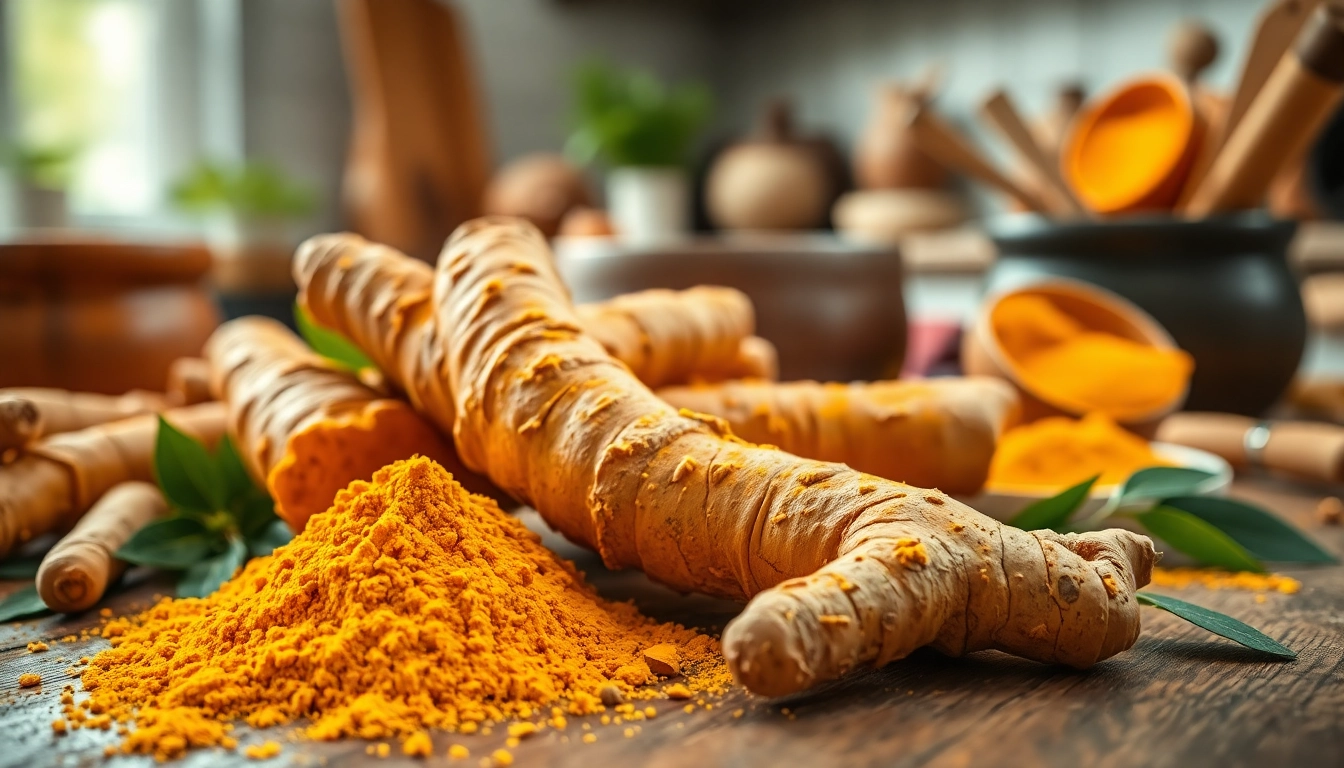Understanding Turmeric Root
What is Turmeric Root?
Turmeric root is the rhizome of the Curcuma longa plant, a member of the ginger family, and is renowned for its vibrant yellow-orange hue. This spice holds a longstanding place in culinary traditions and medicinal practices across Asia and beyond. The rhizome is typically dried and ground into a fine powder but can also be used fresh for its distinct flavor and impressive health benefits. Turmeric is commonly encountered in various dishes, notably in Indian cuisine, where it forms the foundation for curry powders and gives color to rice and meat dishes. For more on this vibrant spice, explore our selection of Turmeric Root.
Historical Uses of Turmeric Root
Historically, turmeric has held significant importance in traditional medicine systems, particularly in Ayurveda and Traditional Chinese Medicine. Ancient practitioners utilized turmeric primarily for its reputed anti-inflammatory and antiseptic properties. It was also believed to enhance digestion and promote liver health. In addition to its medicinal use, turmeric has been regarded as a valuable ingredient in rituals and ceremonies, symbolizing purity and prosperity. The spice’s enduring legacy underscores not only its culinary appeal but also its integral role in cultural traditions.
Turmeric Root vs. Other Spices
When compared to other spices, turmeric stands out due to its active component, curcumin, which contributes to its unique health benefits. While many spices like ginger and garlic also possess beneficial properties, turmeric’s robust anti-inflammatory and antioxidant effects, linked largely to curcumin, distinguish it in the realm of superfoods. Turmeric’s deep yellow-orange pigment sets it apart visually and chemically from many other commonly used spices, such as black pepper or paprika, adding not just flavor but also nutritional enhancement to a variety of dishes.
Nutritional Profile of Turmeric Root
Key Nutrients in Turmeric Root
Turmeric root is not only a culinary delight but also a powerhouse of nutrition. It contains essential vitamins and minerals, including vitamin C, vitamin B6, iron, and potassium. Moreover, turmeric is rich in dietary fiber, promoting digestive health. The high levels of curcumin and other bioactive compounds, such as turmerone and zingeberene, lend turmeric its characteristic health-promoting properties, making it a valuable addition to a balanced diet.
Health Benefits Supported by Research
Numerous studies have highlighted the potential health benefits of turmeric. Research emphasizes its anti-inflammatory, antioxidant, and antibacterial effects, suggesting benefits for conditions such as arthritis, heart disease, and certain types of cancer. A 2020 study demonstrated that curcumin could improve markers of inflammation and chronic diseases, establishing it as a significant contributor to overall health and well-being. Furthermore, ongoing research is investigating turmeric’s role in supporting metabolic health, mental clarity, and overall longevity.
Curcumin: The Active Component
Curcumin is the primary active ingredient in turmeric and is primarily responsible for its golden-yellow color and numerous health benefits. Its potent antioxidant properties help fight free radicals in the body, which can lead to oxidative stress and chronic diseases. Moreover, curcumin’s ability to modulate various biochemical pathways makes it a focus of extensive research, with studies suggesting potential roles in reducing the risk of Alzheimer’s disease, enhancing mood, and supporting cardiovascular health. In essence, curcumin solidifies turmeric’s status as a remarkable health-promoting spice.
Culinary Applications of Turmeric Root
How to Prepare Turmeric Root?
Preparing turmeric root can be done in several ways, depending on how you wish to incorporate it into your meals. Fresh turmeric root can be peeled and grated, similar to ginger, or sliced and added to dishes for a vibrant flavor boost. For those using dried turmeric powder, it can be stirred into soups, stews, and sauces, or mixed into marinades. A common preparation method includes infusing turmeric in warm water or milk to create a soothing and healthful beverage known as “golden milk.”
Delicious Recipes Featuring Turmeric Root
Incorporating turmeric root into your diet can be both flavorful and nutritious. Here are some delicious recipe ideas:
- Golden Milk: A warming beverage made with milk, turmeric, a pinch of black pepper, and sweeteners like honey.
- Turmeric Rice: Combine sautéed onions, garlic, turmeric, and vegetable broth for a fragrant rice dish.
- Curried Lentil Soup: Use turmeric as a base spice in a hearty lentil soup for depth and health benefits.
- Roasted Vegetables: Toss seasonal vegetables with olive oil, turmeric, salt, and pepper before roasting for added flavor.
Popular Pairings and Flavors
Turmeric pairs well with a variety of ingredients to enhance both flavor and health benefits. Black pepper is especially noteworthy, as it contains piperine, which can increase curcumin absorption by up to 2000%. Other complementary flavors include coconut milk, garlic, ginger, and citrus, all of which can be utilized in recipes to create a harmonious blend of taste and nutrition. Combining turmeric with fats (like olive oil or ghee) may also aid in its absorption.
Health Benefits of Regularly Consuming Turmeric Root
Anti-inflammatory Properties of Turmeric Root
One of the most significant health claims associated with turmeric is its powerful anti-inflammatory properties. Chronic inflammation is linked to several diseases, including heart disease, cancer, and neurodegenerative disorders. Studies suggest that curcumin can inhibit certain inflammatory pathways in the body, thus helping to mitigate arthritis symptoms and improve joint health. Regular consumption of turmeric could thus play a pivotal role in reducing chronic inflammation and promoting overall health.
Potential Benefits for Digestive Health
Turmeric has been traditionally used to support digestive health. Its natural antiseptic properties may help maintain a healthy digestive tract and combat bloating and gas. Additionally, curcumin’s ability to stimulate bile production can aid in the digestion of fats. To harness these benefits, many incorporate turmeric into their meals or consume it in supplement form as part of a daily routine to optimize digestive function.
Impact on Overall Wellness
Beyond specific health benefits, turmeric is praised for its overall positive impact on wellness. Its antioxidant properties help neutralize free radicals and combat oxidative stress, which can lead to chronic diseases. Regular consumption can boost immune function through its antimicrobial properties and enhance cognitive health. Moreover, turmeric has been linked to improvements in mood and mental clarity, potentially serving as a natural enhancer of emotional well-being. As part of a balanced diet, turmeric root may effectively support a holistic approach to health.
Buying and Storing Turmeric Root
Where to Buy Fresh Turmeric Root
Fresh turmeric root can typically be found in well-stocked grocery stores, health food stores, or farmers’ markets. When selecting fresh turmeric, look for firm, unblemished roots with a rich orange color. Dried turmeric powder is widely available, and purchasing organic versions can ensure higher quality and purity. Online stores, including specialty spice shops, often offer authentic selections that may not be available locally.
Storage Tips for Freshness
To preserve the freshness of turmeric root, store it in a cool, dry place. Wrap it in a paper towel to absorb moisture and place it in a perforated plastic bag in the refrigerator. Fresh turmeric can last up to several weeks when stored properly. For longer storage, consider freezing the root: peel and cut it into smaller pieces, then freeze in an airtight container or freezer bag.
Choosing Quality Turmeric Products
When purchasing turmeric products, consider factors such as origin, purity, and processing methods. Organic turmeric is preferable as it is grown without synthetic pesticides or fertilizers. Additionally, look for products that provide information about curcumin content, as higher levels are indicative of more potent health benefits. Review labeling for any additives or fillers, prioritizing products that contain only pure turmeric.



